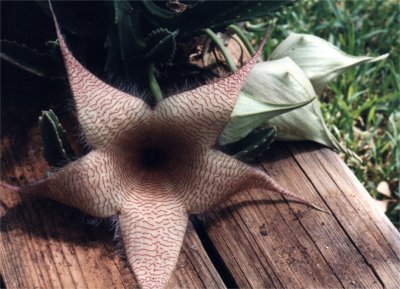Carrion Flower
by Valerie (August 11, 2000)
|
We have had a potted carrion flower (Stapelia gigantea) for many years and it continues to grow and bloom in spite of the fact that it has very little soil in its pot. This plant produces huge buds and flowers (about 8 to 12 inches across). Because the stems get so long, they often get broken off and so we also have this same plant growing in an outdoor garden (which gets covered over during freezing temperatures). This plant is one of numerous species that have similar characteristics but rather varied blooms. They are native to South Africa.
 As one can surmise from the name, the flowers don't smell particularly pleasant. They lure flies to do their pollinating for them, and they do this with a number of ingenious adaptations. The surface of the flowers is covered by fine "hair" and the overall color is flesh-toned. The color of the center of the flower is a deep red, like a wound, which is what flies would normally be attracted to on a carcass. Then, of course, there's the smell. It really is putrid, and so convincing that flies even lay their eggs on it, although when the maggots hatch, they starve to death, since there really isn't a cadaver there for their nourishment. The carrion flower has a number of other common names, as creative as it is strange. It is called Zulu giant, hairy starfish flower, star cactus and starfish cactus. These last two names are misleading since this is not a cactus at all, but the blossoms do resemble starfish. |